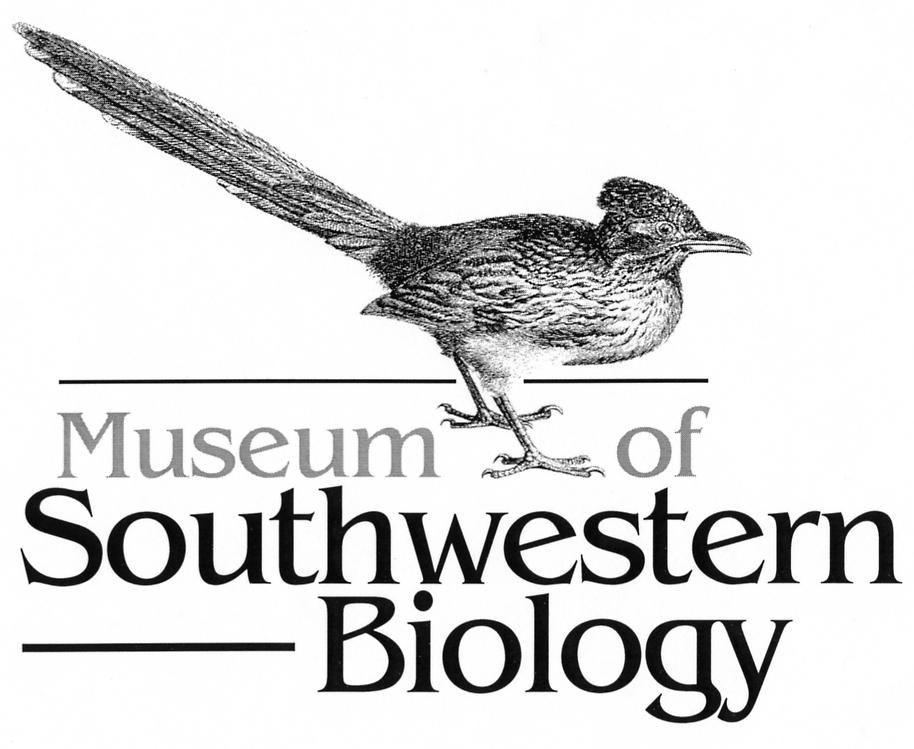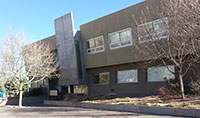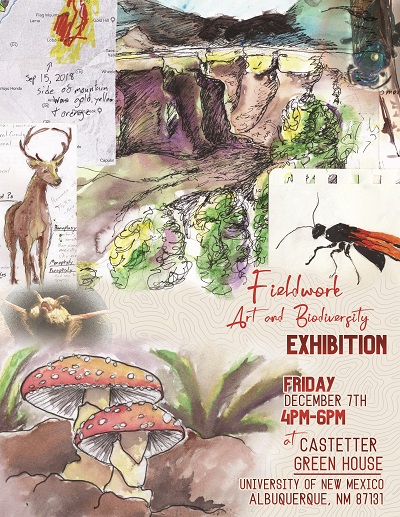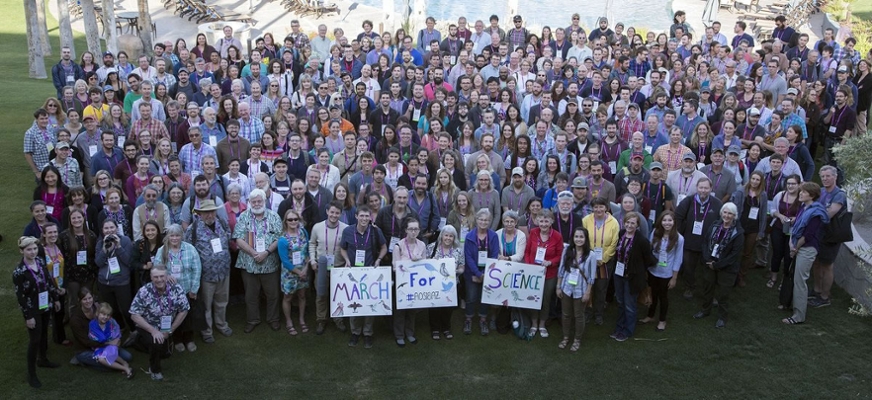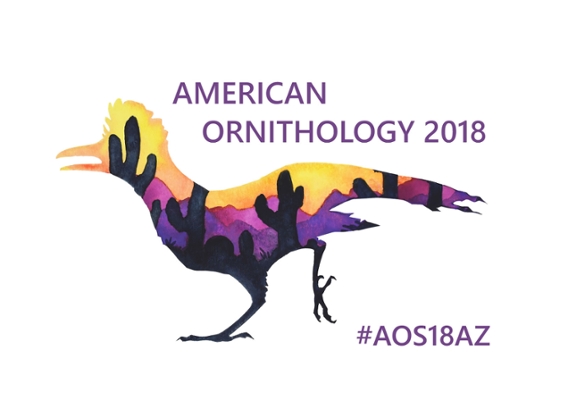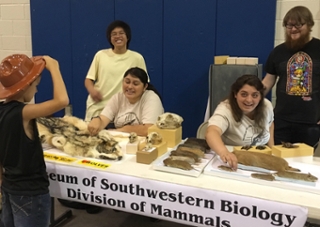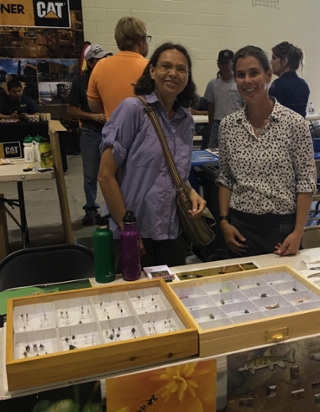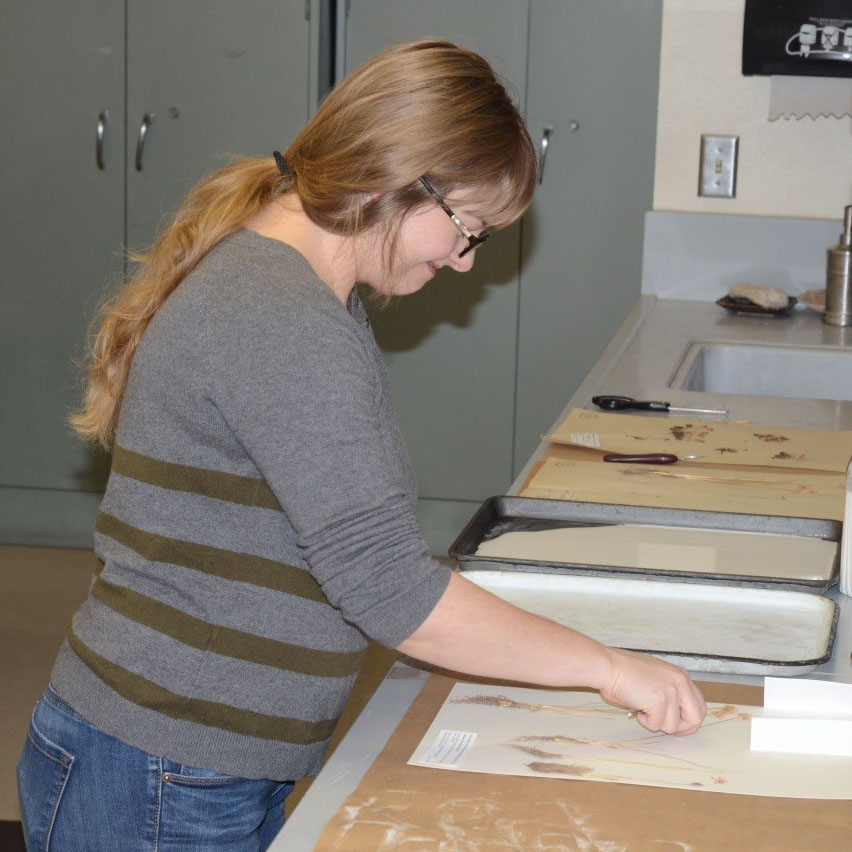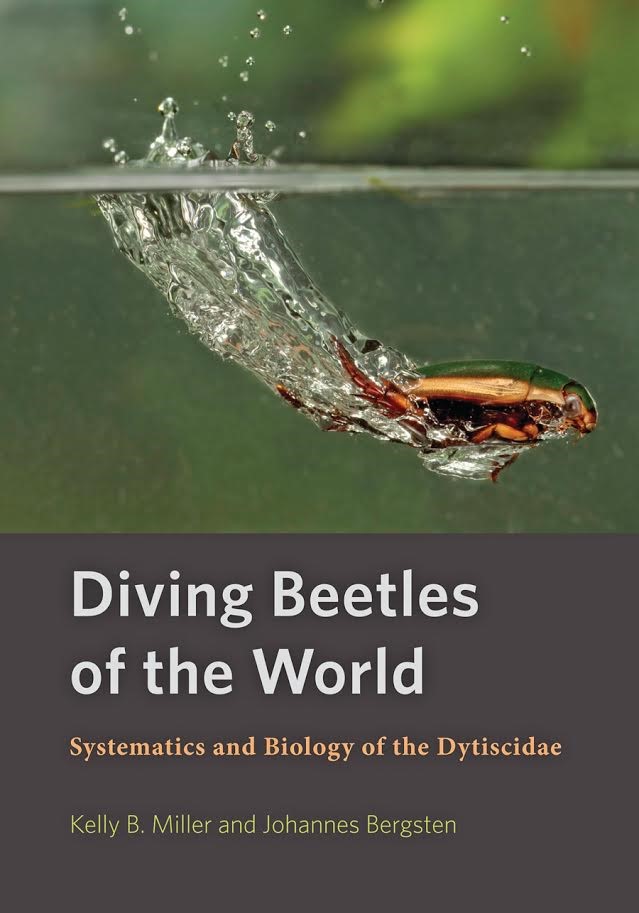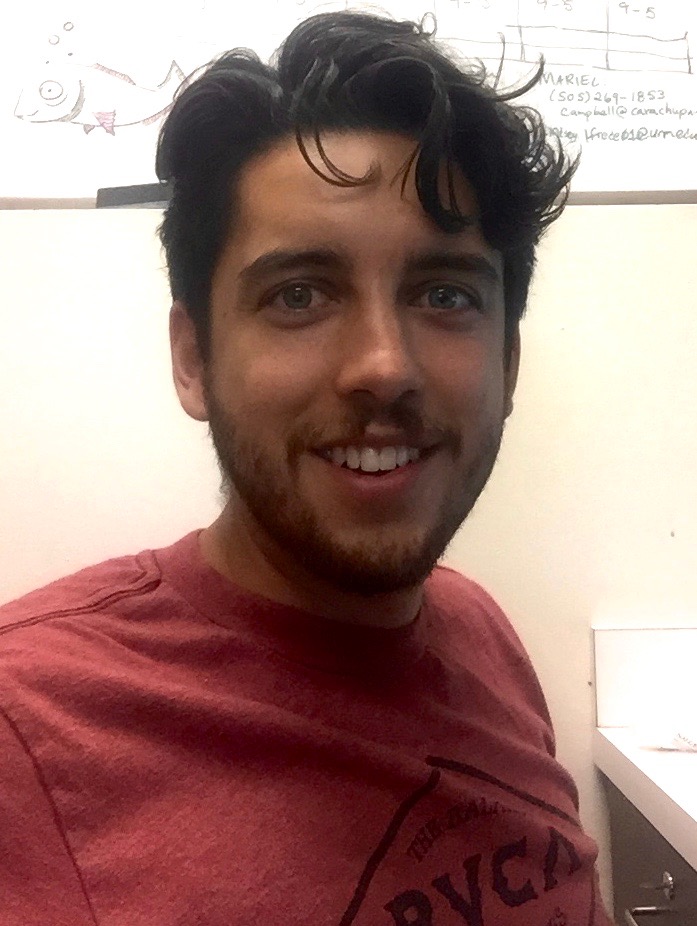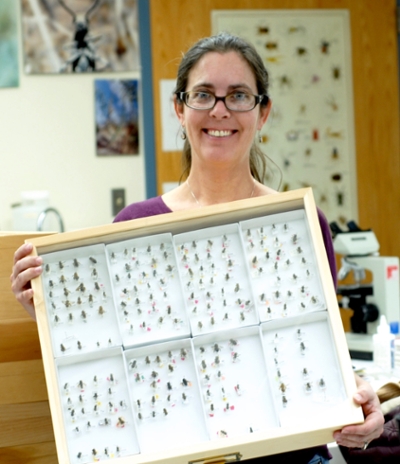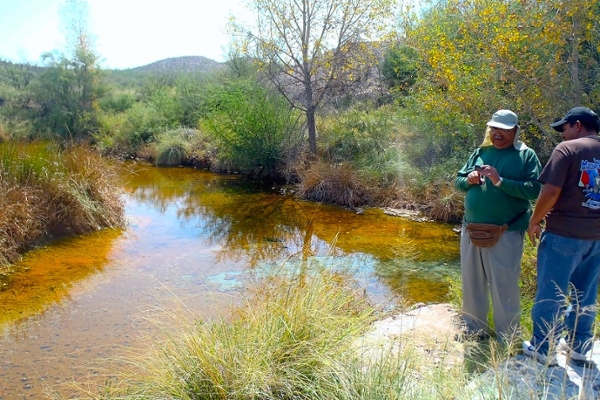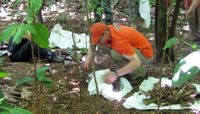Past News
Seeking New Data Manager for Natural History New Mexico
July 9, 2019
The Feather Thief: An evening with the author, Kirk Johnson
Tuseday, April 30
Please Join Us: The Museum of Southwestern Biology and The Central New Mexico Audubon Society for a fun filled eveing with Kirk Johnson, author of: The Feather Thief: Beauty, Obsession, and the Natural History Heist of the Century. Kirk will give a talk and sign his books, available on site from Bookworks at the University of New Mexico's Continuing Education Auditorium, 1634 University Blvd. NE, Albuquerque, New Mexico. The Museum of Southwestern Biology's, Division of Birds, will have a special collection on display before the talk.
See you there!
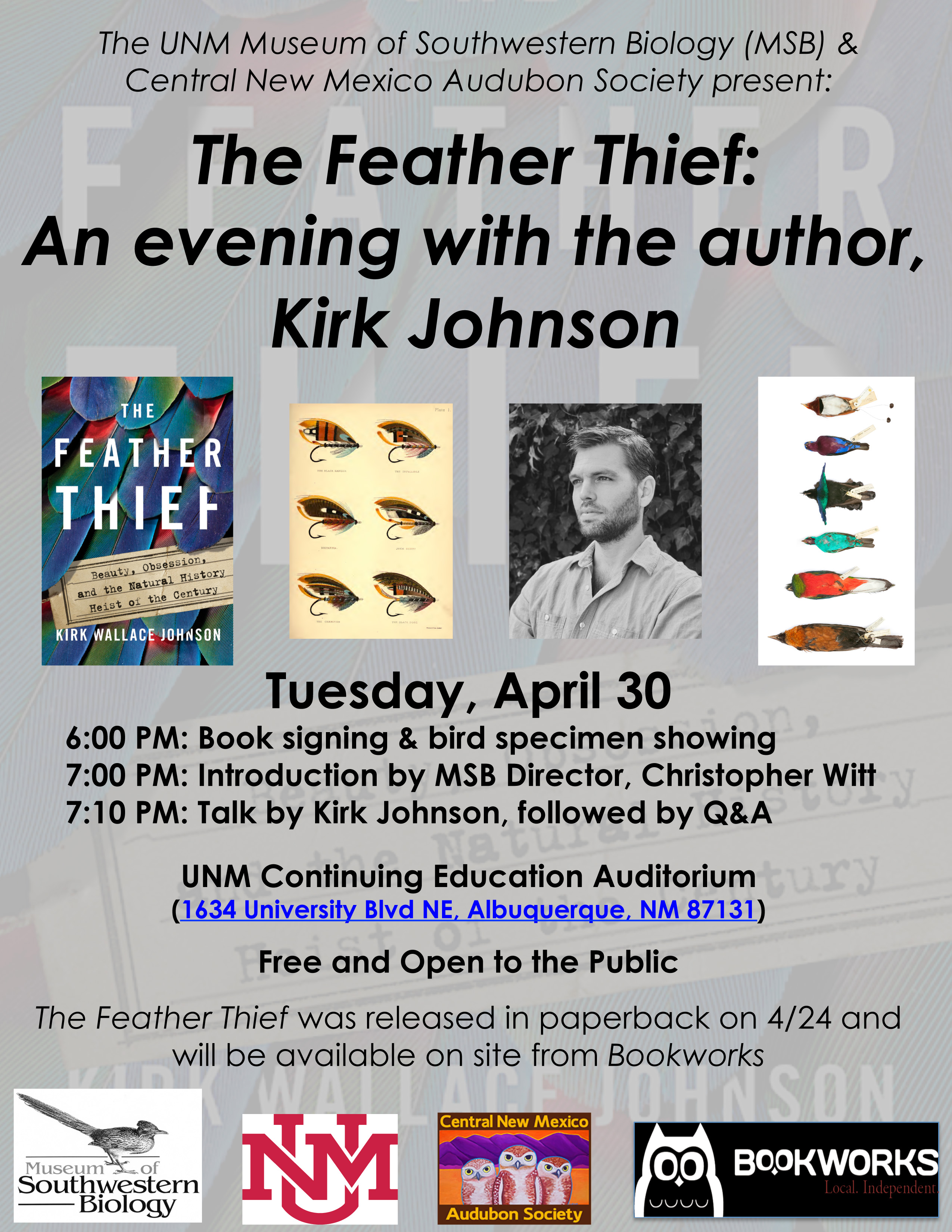
MSB to Host Two Open-Collections Events
March 28, 2019
MSB will open its doors and collections to show off its expansive scientific collections of biodiversity specimens.
First, on Thursday, 3/28, 4:30–6:30PM, MSB invites the UNM community to attend its annual Research Day Open House, held in conjunction with the UNM Department of Biology Research Days.
Second, on Sunday, 3/31, 2:00–5:00PM, MSB will open to the general public for the first time in this special event: The Science of Biodiversity, an Open-Collections Event at the Museum of Southwestern Biology. This event will be free and open to anyone who is interested in learning more about the evolutionary origins, ecology, and conservation of the world’s biota.
Student researchers, curatorial assistants, staff, and faculty curators will be on hand to exhibit a variety of specimens and explain the latest research findings to emerge from our collections.
We hope to see you there!
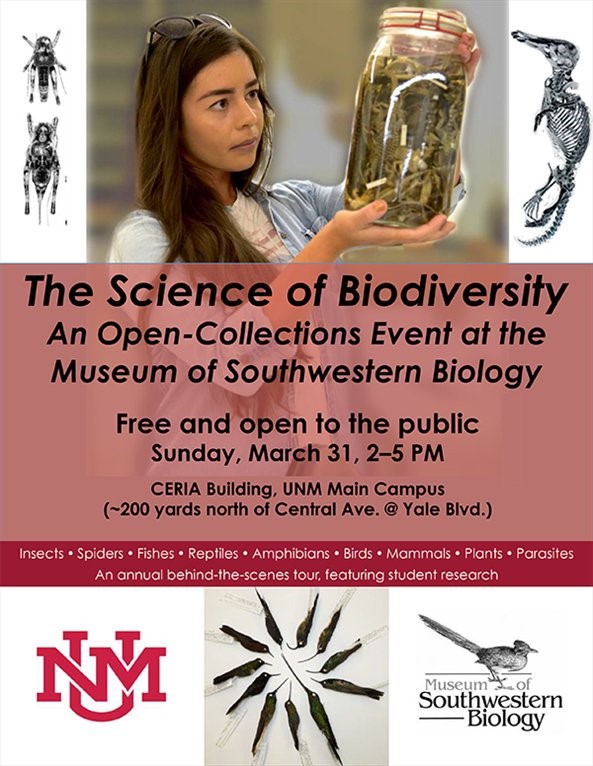
14 December 2018
Swimming in Time at MSB
 Mari Aoki and Priscila Camila De la Pena Schott UNM Swimming and Diving teammates
Mari Aoki and Priscila Camila De la Pena Schott UNM Swimming and Diving teammatesThis fall at MSB, we are aided in our mission by two student athletes volunteering at the UNM Herbarium. Mari Aoki contacted us about the possibility of helping out as part of her University 101 class that requires that students take part in community service opportunities. She mentioned her interest in learning more about how organisms have unique adaptations to various ecosystems. Within just a few days Mari arrived in the museum, joined by her teammate Pris. They now participate in our team of students that are imaging our botanical collection, creating a digital reference for our holdings.
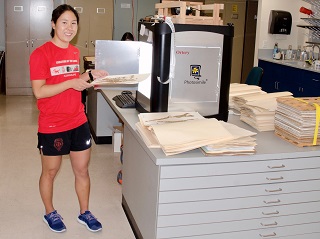 Mari holds an 1887 specimen of Engelmannia peristenia,imaged for viewing through our data portals.
Mari holds an 1887 specimen of Engelmannia peristenia,imaged for viewing through our data portals.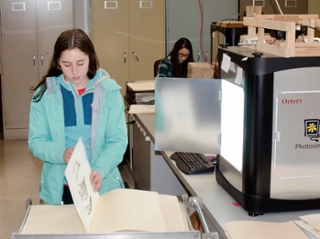 Priscilla replaces specimen after capturing image for Internet.
Priscilla replaces specimen after capturing image for Internet.To view the image Mari created, click on the link below: Herrick1887
Museums are places that hold mystery even to those of us that work here daily; there is always something new, collected years ago, awaiting our discovery as we come for a visit, or to work. We have specimens going back through generations to the 1800s evoking a sense of wonder about history, life, and change in those that visit.
Mari and Pris are here now, immersed in our collection and the depth of history and diversity it represents, sharing New Mexico’s plant specimens with a larger, more diverse audience than research museums traditionally reach. They have been capturing images of specimens that were collected recently, or years ago. Their service honors those that have come before, collectors following their sense of curiosity about a slightly younger world. These collectors and their specimens inform our understanding of global biodiversity. Images collected by Mari and Pris can be viewed worldwide, now, and in the future, further contributing to what becomes available with the passage of time. Modern technology is opening museums to a much wider audience than ever before through digital representation of our holdings.
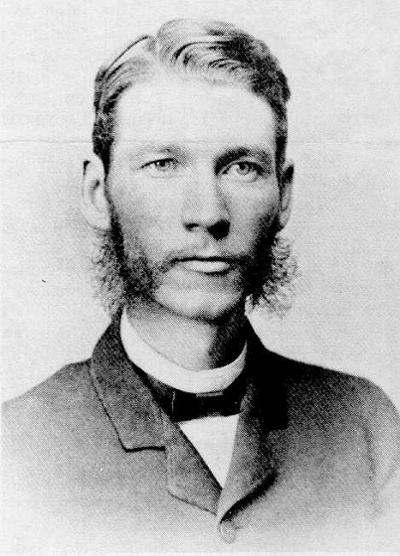 Clarence Herrick, Botanical Collector, Geologist, founder of Developmental Psychobiology, and 2nd president of UNM.
Clarence Herrick, Botanical Collector, Geologist, founder of Developmental Psychobiology, and 2nd president of UNM.Clarence Herrick had a vision to start an Herbarium at UNM in the 1800s. He could not have foreseen how his life and his collections could have come to intersect with technology and students’ lives in 2018. Somehow time becomes insignificant when you are holding a specimen. There it is, a life form in your hand, and an opportunity to notice that the paper is faded and the label is in cursive. As we notice these things the poetry of time opens and there’s a connection to a man in his late thirties documenting the world that he lived in. One of his many contributions is right there in your hand, or now that it is digitized, on your computer screen. We don’t know how our lives will touch the world but in taking steps to document our surroundings we preserve and share things that could only have been guessed at. Life has more connections, more connectivity, than we will ever know. Mari and Pris, like Clarence before them, are sharing that gift of their personal attention to detail, making the connectivity that is life a little more available for others through their service.
More of these students’ efforts can be found on SEINet: http://swbiodiversity.org/seinet/collections/index.php
Thanks to work by student employees and volunteers we are able to offer over 65,000 images on SEINet and other biodiversity data portals. The UNM Herbarium houses over 10,000 plant taxa (species, varieties, and subspecies); life forms representing unique adaptations to the varied landscapes and habitats where they occur.
Test
18 October 2018
MSB is searching for a new Collection Manager for Fishes
Division of Fishes
Museum of Southwestern Biology
University of New Mexico
The Museum of Southwestern Biology (MSB) is seeking a Senior Collection Manager for the Division of Fishes (http://msb.unm.edu/divisions/fishes/index.html). The Fish Collection is located in a state-of-the-art facility in the center of the University of New Mexico (UNM) Main Campus in Albuquerque, a vibrant research and education facility associated with the Department of Biology in the College of Arts and Sciences. The MSB develops and maintains natural history collections explicitly for use in research and education, benefiting the university, science, and society. The scientific role of the MSB is to facilitate and engage in specimen-based studies of ecology, evolution, systematics, and biodiversity informatics, and to train students in these disciplines. The MSB Division of Fishes also serves conservation science and management of aquatic resources in the southwestern United States and beyond.
The MSB Fish Collection is the largest of its type in the southwestern US and comprises more than 100,000 lots of more than 4.5 million specimens. Research in the collection focuses on long-term population studies, community ecology, reproductive biology, and genomics. The collection provides an exceptionally well-documented record of the profound changes to biodiversity that have occurred in the desert southwest over the last century.
We seek candidates with a strong commitment to a vision of the Fish Collection as a key resource for research and education within the University, and to the scientific and conservation community nationally and internationally. Within the context of the curatorial priorities of the Fish Collection, this position offers opportunities for mentoring, career development, research, public outreach, fieldwork, and involvement in undergraduate and graduate education.
Education and Experience:
A Master’s Degree with at least 5 years of collection experience is required, and a Ph.D. can substitute for some of the experience. A strong background in ichthyology is required, including knowledge of taxonomic principles and familiarity with fish collections. The successful candidate should demonstrate strong skills in collection management, organization, and supervision, and should have a record of accomplishment with respect to the development, promotion and use of collections. Demonstrated database skills are also essential. Imaging skills and genetic resource management skills are desirable.
Knowledge, Skills, and Abilities:
The successful applicant must have demonstrated expertise in ichthyology, preferably with knowledge of taxonomy of global and regional (southwestern US and northern Mexico) fishes, and have experience in natural history collection use and management. Candidates should have experience with relational databases (such as Microsoft Access or Arctos), as well as familiarity with online data aggregators and current digitization efforts in biodiversity collections. Curation and digital management of genetic resources (tissues) is an important component of this position. The Collections Manager of Fishes will serve as an advocate for natural history collections, and must be able to communicate their importance to members of the public and to the university and scientific communities alike. Exceptional organizational skills are required.
Essential Functions:
Curation (care, maintenance, improvement, and growth of collection, as well as database management, and processing of loans). Service (including grant writing), outreach, & professional development. Research as appropriate in the context of curatorial priorities.
Duties and Responsibilities:
- Curate physical specimens, including specimen preparation, and organization, care, and housing of specimens and associated tissues or other ancillary materials (such as field notes). Conduct and coordinate processing of new and existing collections, including accessioning, physical preparation, labeling, cataloguing, and loans.
- Establish priorities for collection care and management in coordination with curatorial and research staff.
- Develop and implement collections management policies aligned with best museum practices and University policy.
- Provide collection access to the research community, including assisting visitors to the collection and processing specimen loans.
- Digitize and document collections and their use, including capturing and managing in a database digital images of specimens and their associated information and field notes.
- Maintain electronic and digital records, and update taxonomic and auxiliary information.
- Collaborate and liaise with external biological data repositories and partners, including but not limited to VertNet, iDigBio, and GBIF.
- Provide periodic support to the museum, university, and professional communities, such as serving on MSB and institutional committees and education teams to develop ichthyology-related content for the broader museum community.
- Train and supervise technicians, students, interns, and volunteers working with the collection.
- Collaborate with the Curator and other museum staff to develop grant proposals for collections improvements and other collection-based initiatives. Manage grants and contracts in coordination with the Curator.
- Provide support for promotional and institutional advancement activities, including opportunities to engage with the public by providing tours of the collection.
The University of New Mexico is committed to hiring and retaining a diverse workforce. We are an Equal Opportunity Employer, making decisions without regard to race, color, religion, sex, sexual orientation, gender identity, national origin, age, disability, or any other protected class.
Apply here:(http://https://unm.csod.com/ats/careersite/JobDetails.aspx?id=6628&site=14)
20 July 2018
MSB Curator Joe Cook named Regents’ Professor by UNM
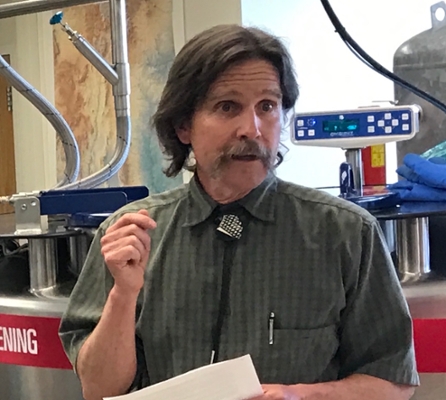 Dr. Joe Cook introducing newly renovated Division of Genomic Resources
Dr. Joe Cook introducing newly renovated Division of Genomic ResourcesJoe Cook’s history at UNM extends to his Master's Degree in the 1980s. He has been Curator of Mammals at MSB since 2003 and he has overseen a period of tremendous collections growth, high-impact research, and prolific student training. He has been a leader by example in many respects, authoring about 10 publications per year, and adding to our collection at an annual rate of over 14,000 specimens. Dr. Cook led MSB as Director for six years, during which time he achieved an historic renovation of the Division of Genomic Resources and transition to liquid nitrogen storage. Now UNM is recognizing Dr. Cook’s achievements with the title of Regents’ Professor, an honor attained by only a small portion of the university’s most distinguished faculty. His scholarship alone merits such an honor, although his contributions to the permanent scientific infrastructure of UNM (i.e. collections) may be unparalleled among active faculty.
22 May 2018
MSB Bird Division makes big showing at big ornithology conference
Five students, staff, and faculty attended and presented research at the 2nd meeting of the American Ornithological Society (AOS). AOS is a new society formed by the American Ornithologists Union and the Cooper Ornithological Society. Attendees included undergraduate Xena Mapel, graduate students Serina Brady, Chauncey Gadek, Jenna McCullough, and Jessie Williamson, postbac fellow Selina Bauernfeind, postdoc Lisa Barrow, senior collections manager Andrew Johnson, curator Christopher Witt, and assoc. curator Blair Wolf. The meeting was in Tucson, AZ, and the conference hotel grounds hosted a nearly full suite of Sonoran desert birds and plants. There were 11 presentations in total from our group spanning both posters and 15-minute talks. Witt was elected to Councilor of AOS at the meeting. It was an inspiring and successful conference!
15 July 2017
Museum Joins Pueblo of Isleta Environmental Fair
The Museum of Southwestern Biology joined more than 50 state and federal agencies and NGOs at the annual Pueblo of Isleta Environmental Fair on Saturday, July 15. Graduate students Kaylen Jones and Lindsey Frederick from the Division of Mammals and the Museums Studies Program, Dr. Megan Osborne from the Division of Fishes, and Dr. Sandra Brantley from Division of Arthropods demonstrated how natural history collections are essential to effective conservation actions and management planning.. Displays by members of the Isleta Pueblo also highlighted their new social and environmental programs.
04 May 2017
Museum Grant brings Colorful Botanical Images to You
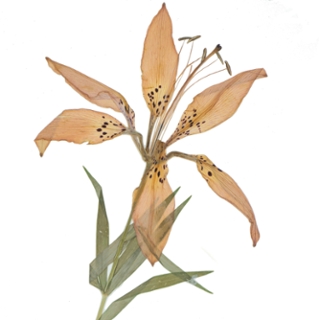
Lillium philadelphicum, Brother A. Benedict, July 8, 1927
The UNM Herbarium will become increasingly noticeable as a place of motion, light, color, and diversity in the near future. UNM was awarded a $200,000 National Science Foundation grant to image and georeference plants of the greater Southern Rocky Mountains. This collaborative multi-institutional (37 partners) grant is funded by NSF’s Advancing Digitization of Biodiversity Collections (ADBC) and we aim to mobilize data from ~ 2.0 million herbarium specimens to help efforts to understand global environmental change. Imaged, georeferenced specimens and data will be available on the SEINet (http://swbiodiversity.org) and iDigBio portals. Students will participate in this opportunity to expand accessibility and utility of our amazing collection of plants (135,000 specimens representing 10,300 species).
15 March 2017
High School Students learnabout Native Fish
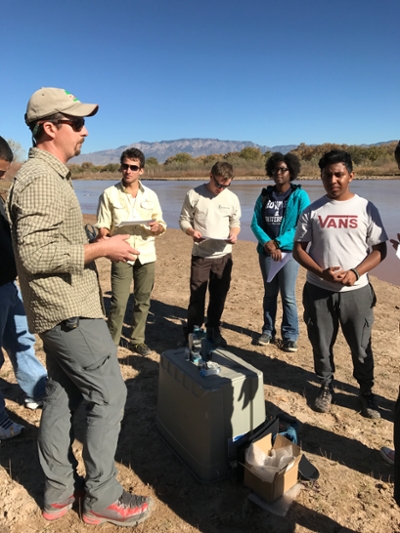
Adam Barkalow, M.Sc. graduate student (with Dr. Tom Turner), lectures high school students from Bosque School and La Academia de Esperanza class on Rio Grande fishes and research. During the 48th annual Desert Fishes Council (DFC) meeting held in Albuquerque, New Mexico (November, 2016) DFC students and young professionals led an outreach event to educate high school students about aquatic ecosystems and their importance. The event was a collaborative effort from DFC members, UNM’s Bosque Ecosystem Monitoring Program (BEMP), New Mexico Fish and Wildlife Conservation Office, and Bosque School. High School students rotated through education stations manned by DFC volunteers and seined for fish in the Rio Grande. Students gained insight into aquatic invertebrates, sexual dimorphism, larval fish development, and museum specimens through hands on experiences on the banks of the Rio Grande. Larval fish collections, curated and archived at the Museum of Southwestern Biology Division of Fishes, gave students the opportunity to learn about native fishes life histories and development through examination of key characteristics under magnification.
16 November 2016
Students working with US Geological Survey
This Fall semester the Division of Arthropods is fortunate to have 3 undergraduates working with us, with funding from the US Geological Survey, to help clear out a backlog of samples from Bandelier National Monument and the Valles Caldera National Preserve. The samples are for ecological monitoring of ground-dwelling arthropods to study the effects of climate change (Bandelier), or the effects of the 2011 Las Conchas fire (Valles Caldera). The students are separating specimens into basic arthropod groups so the taxonomists can make species identifications and prepare specimens for the museum collection.
The students are working with Mark Ward, the entomologist overseeing the Valles Caldera monitoring; Rachael Alfaro, the GA for our division; and Sandy Brantley, the collection manager for alcohol specimens. Wes said that working with us is like having another class, because we’re there to answer questions about arthropod diversity and evolution.
|
|
Lozen Benson is a junior, changing her academic direction from biology to philosophy, languages and art. She’s considering applying to the Honors College because of her wide range of interests. She’s from Silver City, NM and enjoys the state’s many natural environments. |
|
|
Joaquin Garcia is a senior, graduating in December 2016 in biology, with a particular interest in conservation. He attended the SACNAS (Society for Advancement of Chicanos/Hispanics and Native Americans in Science) meeting in Long Beach, CA, earlier this year. Joaquin is applying to graduate schools in Washington, preferably for research in vertebrate conservation. |
|
|
Wesley Noe is a senior, graduating in biology with a chemistry minor in May 2017. He is taking Chris Witt’s high altitude biology class this semester and will take Howard Snell’s conservation or wilderness biology class next semester. Wes’s interests are in ecology and sustainability of habitats. |
.
21 October 2016
Announcing the Publication of Diving Beetles of the World
The Museum of Southwestern Biology is proud to announce the publication of Diving Beetles of the World by Dr. Kelly Miller, our very own Curator of Arthropods, and co-author Johannes Bergsten of the Swedish Museum of Natural History. Diving beetles, Family Dyticidae, are diverse (>4,300 species in 188 genera) aquatic beetles found world-wide that are important predators in freshwater aquatic ecosystems. Essential to ecologists, limnologists, naturalists, and insect taxonomists, Diving Beetles of the World, will help to identify and classify water beetles through richly illustrated keys, high-resolution images, details on life history and biogeography, and maps. Get your copy of the First Edition while they’re still available!
 Dr. Miller and Dr. Bergsten at the 2016 International Congress of Entomology.
Dr. Miller and Dr. Bergsten at the 2016 International Congress of Entomology.
5 August 2016
Transitions are Common at MSB
The Museum of Southwestern Biology employs many students across our divisions and these student gain valuable hands-on experience in fieldwork, specimen preparation, data literacy and database development, and integration across sample-based research disciplines. This Fall (2016), two of our former student employees are entering the Water Resources Master’s Program at UNM.
|
|
Drew Vanetsky took classes (Tropical Biology) and a directed study in island biology course with MSB faculty, worked in the Mammal Division, and then went on a two year walk about in Africa working with a variety of environmental programs. After returning to Albuquerque, he applied to graduate school.
"My favorite part of working at the MSB was processing the mammal specimens, especially the larger ones such as wolves. It was extremely interesting to dissect these specimens, collect tissue and parasite samples, and prepare the skeletons and pelts for storage in the collection. The dissections were excellent practice for my later experience assisting a wildlife veterinarian with necropsies in Southern Africa."
|
|
|
Matt Segura has worked with the Bird and Genomic resources Divisions for the past three years and has been key to processing thousands of bird tissue samples that have come from fieldwork in Andes and in New Mexico.
“Working at MSB opened my eyes to multidisciplinary collaboration. I liked the openness of the museum and the closeness that all the different scientists share. This job showed me what a research job can entail and it allowed me to become a part of that world. I was able to participate in many forms of research, which helped me to ultimately find what my passions are.”
|
11 April 2016
Meet the New Assistant Curator of the Texas A&M Insect Collection
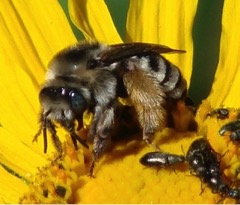
photo by John Ascher
Congratulations! Karen Wright, a PhD Candidate in the MSB's Division of Arthropods, has been hired as the new Assistant Curator for the Texas A&M University Insect Collection (TAMUIC) in the Department of Entomology. TAMUIC is one of the top insect collections worldwide with nearly 2.8 million specimens covering over 45,000 species! At the MSB, Karen was curatorial graduate assistant for both the Division of Arthropods and the Herbarium. Karen’s dissertation explored the evolution of diet breadth in the bee genus Melissodes and has developed a long-term dataset of bee diversity at the Sevilleta National Wildlife Refuge. Karen will arrive at TAMUIC with a broad knowledge of bee and plant taxonomy, where she will not only supervise undergraduate assistants, but also interface with Texas State Agricultural Extension Office, Department of Entomology faculty and graduate students, the public, and other natural history collections at Texas A&M University. Karen has been a tremendous asset to the MSB and will be greatly missed. We wish her great future success and know that TAMUIC is gaining an invaluable resource and dedicated scientist
more
Texas A&M University Insect Collection
pollinator video
30 November 2015
Remounting Historical Collections at the UNM Herbarium:
The Brother Arsène Collection
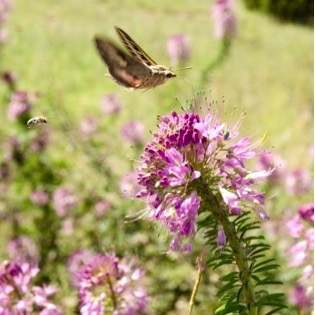
The Bee Plant, Peritoma serrulata, attracts pollinators including a Sphynx moth (Hyles lineata) and two bee species (a sweat bee, Agopostemon sp. and a mining bee, Colletes sp.). The Museum of Southwestern Biology captures these important interactions by preserving examples of these species for research, education, and as a historical record of the natural history of the Southwest.
One older specimen, pictured here, was collected by two French monks, Brother Benedict (Marcellin Marien Lacas) and Brother Arsène (Arsène Gustave Joseph Brouard) who lived in Santa Fe in the 1920s and 30s. Their historically important collection of nearly 2000 plants was donated to the Museum of Southwestern Biology by the College of Santa Fe and is now being restored.
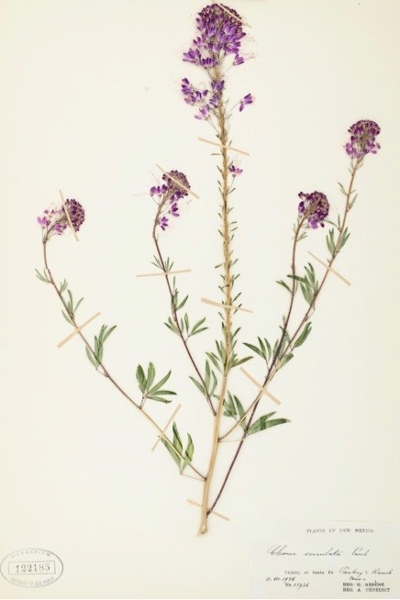
This Bee Plant specimen was collected 89 years ago and recently remounted on acid-free paper to ensure that the entire collection will allow future generations to enjoy and study these early records. The collection preserves not only the plant and its label, but also the sense of wonder of two men who independently made journeys from France to the New World and the American frontier via Cuba and Mexico. Just as a work of art can capture a time and place and sense of connection to a landscape, this Rocky Mountain Bee Plant captures the devotion and curiosity within two naturalists’ lives by preserving their aesthetic and attention to the world that they lived in. Many plants mounted on acidic paper suffer some degradation associated with the passage of time using non-archival materials. Now stored on new paper in cool dry conditions, these specimens should be around for research and re-discovery for generations.
All sheets were imaged in their original condition and the original label has been preserved in an acid-free fragment pack. Curating old specimens is time consuming but rewarding. Old or new, our specimens are available to interested visitors to the Museum of Southwestern Biology, and through their images, now to our global web community.
read more
an Albuquerque Journal article about the acquisition
an article published online about this historical collection
a list of Brother Arséne Brouard's writings
17 February 2015
Holistic Approaches to Conservation of Desert Wetland Ecosystems
Dr. Evan Carson of the MSB Division of Fishes is one of the authors of a recently published book that highlights collaborative efforts at El Pandeño Spring in Julimes, Chihuahua. This holistic project, which encompassed the spring and its surroundings, is the flagship of a larger model for conservation of desert wetlands in arid lands of México.
El Pandeño Spring is highly modified from its natural state, yet it maintains a remarkable suite of native species and even species only found at this site, including the Julimes pupfish. Researchers focused their efforts on this pupfish, but were also interested in a rare isopod, mud snails, and a mosquitofish never described by science. Scientists worked with local landowners and farmers to restore a former marsh, but they also worked to ensure sustainable development of water resources, which are essential for crop irrigation in the community. The authors are happy to report that this cooperative, holistic approach to restoration resulted in a rebound of the pupfish population.
read more
20 January 2015
Too wet for frogs: La Niña disrupts tropical frog leaf litter communities
Extreme climate events such as an El Niño or La Niña weather patterns can wreak havoc on global economies, health systems, and plant and animal communities. In tropical Costa Rica, where rainfall is usually abundant, researchers from the University of New Mexico and the University of Costa Rica (UCR) set out to study the effects of a record-breaking La Niña event on frogs in their natural habitat.
Led by Ph.D. candidate Mason Ryan, the group surveyed frogs over a five-year period that included the 2010-2012 La Niña event. The research, titled “Too wet for frogs: changes in a tropical leaf litter community coincide with La Niña,” was published today [13 January 2015] inEcosphere, a journal of the Ecological Society of America.
The role of extreme rainfall associated with a La Niña event is not well-known for amphibians in tropical areas, but one would’t expect abundant rainfall to harm populations of moisture-loving organisms like amphibians. Leaf litter frogs live in a humid and moist environment comprised of dead leaves and other forest debris that falls to the ground. The onset of the 2010-12 La Niña provided a natural experiment with which to address the effects of excess rainfall on this community. Ryan and colleagues documented extreme changes in leaf-litter frog populations that coincided with the La Nina event.
read more
